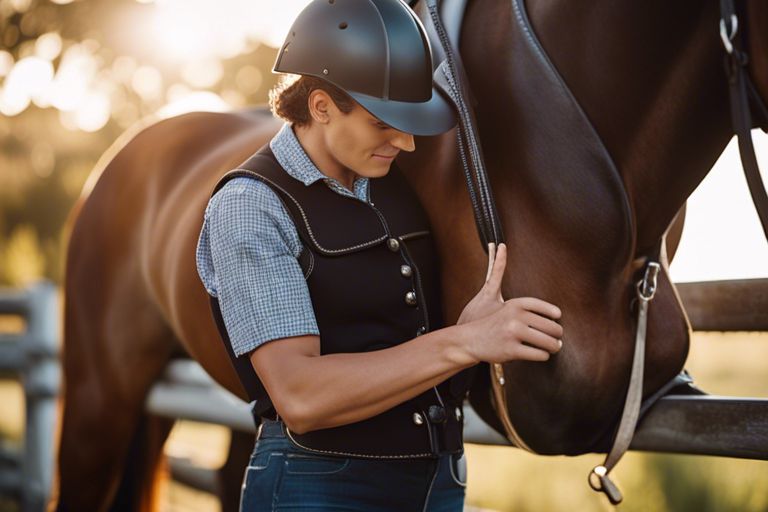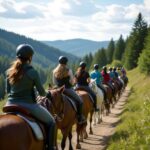You saddle up for a trail ride, but do you know the imperative do’s and don’ts of trail riding etiquette? Stay on the right path by following these key guidelines to ensure a safe and enjoyable experience for both you and fellow riders. Bear in mind, ignoring trail etiquette can lead to dangerous situations and ruin the ride for everyone. So, let’s venture into the world of trail riding do’s and don’ts.


Pre-Ride Etiquette
Before you head out on the trails, there are some key aspects of pre-ride etiquette to keep in mind. By following these guidelines, you can ensure a positive experience for yourself and others on the trail.
Respecting Trail Access
To start off on the right foot, make sure you have the necessary permits or permissions to access the trail you plan to ride on. **Respecting** trail access is crucial for maintaining good relationships with landowners and preserving trail access for future riders. Always check ahead of time if there are any restrictions or guidelines you need to follow.
Parking and Unloading
PreRide, when you arrive at the trailhead, be mindful of where you park and unload your horse. **Parking** in designated areas and following any specific instructions regarding trailers helps keep the trailhead organized and safe for everyone. Ensure **another** important point mentioned is that you unload your horse away from traffic flow, ensuring the safety of both your horse and other trail users.
On-Trail Etiquette
Any etiquette guide for trail riding must include a section on on-trail etiquette to ensure a safe and enjoyable riding experience for all. This section will cover right-of-way rules, speed and noise control, passing and overtaking, and other important considerations while riding on trails.
Right-of-Way Rules
Rules regarding right-of-way are crucial to maintain safety on the trail. Do not forget, when encountering other trail users such as hikers or bikers, yielding is imperative. If you are riding downhill, yield to those riding uphill, as they may have a harder time stopping and starting again. Additionally, yield to smaller or slower-moving animals, as they may be easily startled.
Speed and Noise Control
Etiquette
The speed at which you ride and the noise level of your horse can greatly affect the experience of others on the trail. Control your speed, especially when passing others, to prevent accidents or startling other riders or animals. Avoid loud noises that could startle wildlife or other riders, like shouting or playing loud music. Maintaining a calm and controlled pace is not only polite but also safer for everyone on the trail.
Passing and Overtaking
The
On-Trail
Understanding

Horse and Rider Considerations
Horse Health and Well-being
Not only should you consider your own comfort and safety while trail riding, but also consider your horse’s well-being and health. An important part of trail riding etiquette is making sure your horse is fit and healthy before commenceing on a ride. Ensure your horse is adequately hydrated, fed, and rested before hitting the trails. Keep an eye on your horse’s behavior and well-being throughout the ride, and be prepared to adjust your plans if your horse is showing signs of fatigue or discomfort.
Rider Safety and Awareness
Awareness is key when it comes to rider safety while trail riding. Always wear appropriate safety gear, including a helmet and sturdy footwear. Make sure your tack is in good condition and fits properly to avoid any accidents or discomfort for both you and your horse. Additionally, be aware of your surroundings at all times and stay alert to any potential hazards on the trail, such as uneven footing, wildlife, or other riders.
Being a responsible rider means taking the necessary precautions to keep yourself and your horse safe while enjoying the great outdoors. Bear in mind, your safety is just as important as your horse’s well-being.
Equine Communication and Body Language
With horse communication and body language, it’s crucial to pay attention to your horse’s signals and cues while riding. Understand how your horse communicates through its body language and reactions to different stimuli. By being in tune with your horse’s communication, you can establish a stronger bond and trust between you and your equine partner.
Understanding your horse’s body language can also help you anticipate any potential issues on the trail and respond accordingly. By interpreting your horse’s signals, you can prevent misunderstandings and ensure a smoother and safer ride for both of you.
Environmental Responsibility
Unlike road riding, trail riding takes you through natural landscapes where environmental responsibility is paramount. As a trail rider, it’s crucial to follow Leave No Trace principles, practice good waste management and disposal, and contribute to trail maintenance and repair efforts.
Leave No Trace Principles
Any time you hit the trails, make sure you adhere to the Leave No Trace principles. These guidelines include packing out all your trash, respecting wildlife by observing from a distance, staying on designated trails, and avoiding damaging vegetation. By following these principles, you help preserve the natural habitat and ensure that future generations can enjoy the trails as well.
Waste Management and Disposal
Environmental responsibility extends to how you manage and dispose of waste while trail riding. Dispose of trash properly in designated bins or pack it out with you. Human waste should be buried in a hole at least 6-8 inches deep and at least 200 feet away from water sources. Carrying biodegradable soap for cleaning purposes can also help minimize your impact on the environment.
Trace
Trail Maintenance and Repair
Trail maintenance and repair are vital aspects of environmental responsibility for trail riders. Participate in trail clean-up events, report any trail damage or hazards you encounter, and lend a hand in repairing minor trail issues you come across. By taking an active role in maintaining the trails, you contribute to their sustainability and longevity, ensuring they remain enjoyable for all users.
Plus

Interacting with Others
Greeting and Communicating with Fellow Riders
One of the key aspects of trail riding etiquette is how you interact with others on the trail. Always greet fellow riders with a friendly hello or nod as you pass by. Communication is important, especially when overtaking or being overtaken. Use clear signals or calls to alert others of your presence.
Dealing with Confrontations and Conflicts
Conflicts can arise on the trail, whether it’s over the right of way or a misunderstanding. If you find yourself in a confrontation, remain calm and respectful. Try to listen to the other person’s point of view before voicing your own. If the situation escalates, it’s best to disengage and report any serious issues to the appropriate authorities.
Another important aspect of dealing with conflicts is to remember that everyone is out on the trail to enjoy nature and have a good time. Respect each other’s space and be considerate of others to ensure a harmonious riding experience for all.
Showing Appreciation and Gratitude
For a positive trail riding experience, always remember to show appreciation and gratitude towards others. A simple thank you or a nod of recognition goes a long way in fostering good relationships with fellow riders. If someone helps you out on the trail, whether it’s with directions or a mechanical issue, be sure to express your gratitude.
Confrontations can be avoided by showing gratitude and acknowledging the efforts of others. A little kindness and gratitude can go a long way in creating a friendly and supportive trail riding community.
Trail Riding Best Practices
Staying on Designated Trails
On your trail rides, always make sure to stay on designated trails. Wandering off the trail can lead to ecosystem damage and habitat destruction. By sticking to the marked paths, you help preserve the natural beauty of the area and minimize your impact on the environment. Additionally, veering off the trail can be dangerous and lead to getting lost, so it’s best to follow the designated route for your own safety.
Avoiding Sensitive Habitats and Wildlife
Practices that involve respecting sensitive habitats and wildlife are necessary while trail riding. Avoid disturbing nesting areas, feeding grounds, or watering holes to ensure the well-being of the local wildlife population. Being mindful of your surroundings and maintaining a safe distance from animals you may encounter is crucial. Keep in mind, you are a guest in their home, so treat the natural world with care and respect.
Riding through natural areas requires a deep respect for the environment and its inhabitants. Be aware of your impact and take steps to minimize disruption to the delicate balance of ecosystems. By following guidelines for interacting with wildlife and sensitive habitats, you can enjoy your trail rides while also protecting the environment for future generations.
Carrying Essential Gear and Supplies
Trail riding can be unpredictable, so it’s important to carry necessary gear and supplies with you. Items like a map, compass, first aid kit, and plenty of water are crucial for any outdoor excursion. Being prepared for unexpected situations such as sudden weather changes or injuries is key to a safe and enjoyable riding experience.
Trail riding is an adventure that requires proper planning and preparation. Carrying necessary gear ensures you are equipped to handle any challenges that may arise during your time on the trails. By being proactive and packing necessary supplies, you can have peace of mind knowing you are ready for whatever comes your way.
Conclusion
Upon reflecting on the trail riding do’s and don’ts, remember that following proper etiquette is important for a safe and enjoyable experience for everyone on the trail. By being courteous, respectful, and mindful of others, you can help maintain a positive atmosphere and ensure that everyone has a great time exploring the great outdoors on horseback.
So, as you saddle up for your next trail ride, keep these guidelines in mind and set a good example for fellow riders. By practicing good etiquette and showing consideration for others, you can help create a harmonious environment on the trails and make the most of your equestrian adventures. Happy trails!
Q: What should I do before hitting the trails for a ride?
A: Before heading out for a trail ride, make sure your horse is well-groomed, tacked up properly, and physically prepared for the ride. Check the weather, trail conditions, and inform someone of your planned route and estimated return time.
Q: Is it important to follow trail etiquette when riding?
A: Yes, following trail etiquette is crucial to ensure the safety of yourself, your horse, and others on the trail. It also helps preserve the trails for future riders and maintain a harmonious relationship with other trail users.
Q: What are some common trail riding do’s?
A: Some common trail riding do’s include yielding to non-equestrian trail users, passing others with caution, staying on designated trails, cleaning up after your horse, and being courteous to fellow riders and hikers.
Q: What are some trail riding don’ts that should be avoided?
A: Some trail riding don’ts to avoid include galloping or cantering in crowded areas, littering on the trails, cutting switchbacks, allowing your horse to graze on vegetation along the trail, and approaching wildlife too closely.
Q: How can I contribute to preserving the trails while trail riding?
A: You can contribute to preserving the trails by staying on designated paths, avoiding muddy or sensitive areas, packing out all trash, not disturbing wildlife or plants, and participating in trail maintenance or cleanup efforts.










